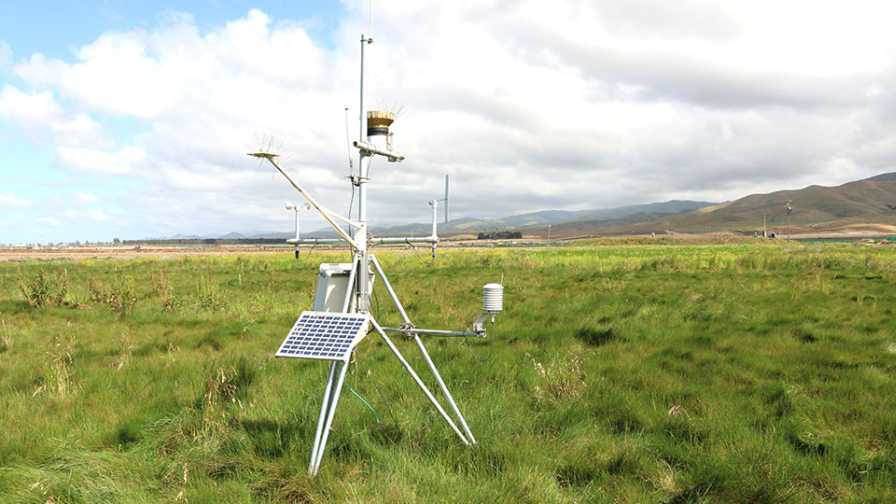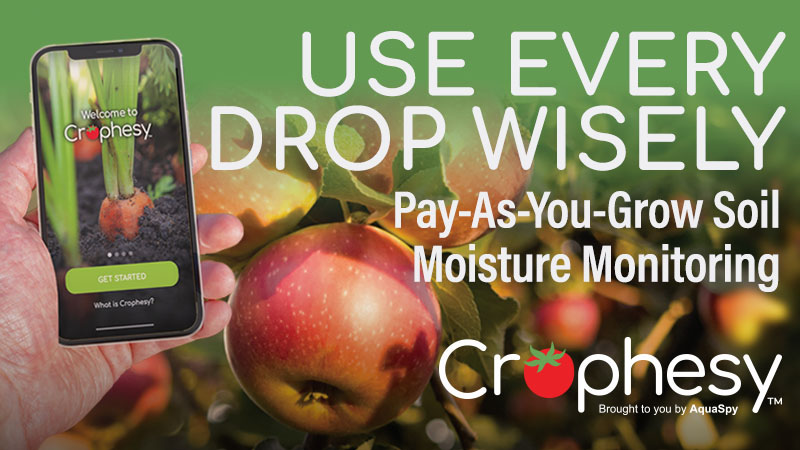Ways Irrigation Can Protect Your Vegetable Crops From Unwieldy Weather

Weather stations that monitor evapotranspiration over a well-watered grass provide a daily reference ET value that growers can use for irrigation scheduling.
Photo by Michael Cahn
Across much of the country, vegetable growers are confronting new weather patterns. It’s more common today to have long dry spells followed by heavy rain. That can make planning for irrigation more difficult. If you have saturated soils slowly drying out, how much water should you apply to your crops? And when?
We reached out to irrigation experts and suppliers to gather advice you can use to improve your irrigation game and keep costs to a minimum by not watering a drop more than you need to.
What are some practical steps growers can take to prepare for the unexpected when it comes to irrigation?
Joel O’Camb, Weather Product Line Manager, Davis Instruments
Monitoring soil moisture levels allows growers to charge lower levels and build health when water is available. Then cut back to, but not beyond, lower levels of irrigation needed for fruit growth. Davis weather stations allow them to monitor evapotranspiration, and thus replenishment, and rain received on site.
Jerry McDonald, President, Grow Irrigation
As growers experience more extreme weather, they are more likely to turn to more water-efficient irrigation methods, even in wetter climates in places like the U.S. Southeast, where water is abundant. It’s not enough to have a large amount of rain every year — it needs to come at the right times.
Drip irrigation, usually drip tape, is the most efficient way to irrigate vegetable row crops. Historically, drip has been most used in arid climates such as California and Arizona. However, as weather becomes more unpredictable, it now makes sense in all vegetable growing regions. When your farm is going through a period of strict water allocation due to drought, the only way to survive may be to stretch that allocation as far as it can go by using drip.
Jim Clare, CEO and Founder of Pacific Southwest Irrigation
The best way to handle dry and wet spells are well designed drip or sprinkler systems, which can be operated at any time (permanent irrigation). These systems are designed to apply water that matches the use of water by the crop. A crop that requires, say, .25 inches of water per day, the system can provide .25 inches a day, or .5 inches in two-day frequency.
Tom Penning, President, IRROMETER Company Inc
Being able to know the actual soil moisture conditions is critical. The use of soil moisture sensors can tell farmers whether water is available to the crop root system. Since their irrigation scheduling patterns will have to adapt to the changing conditions, such feedback is vital to an understanding of the soil water dynamics.
Farris Hightower, Regional Sales Manager, Lindsay Corporation
Growers should work closely with their local irrigation dealer when designing an irrigation system to determine the quantity and quality of their water source, along with pumping and crop water requirements. Then they should work together to design a system that will meet the specific needs of each field. The local dealer will also provide preventative maintenance programs to mitigate the unexpected and be available for service and parts should the need arise.
In today’s environment, a grower should also consider the remote monitoring, control, and scheduling technology offered by the manufacturer, which not only helps growers save time, money, and labor, but also increases profitability and sustainability.
Bruce Moeller, CEO, AquaSpy
When it comes to irrigation, having actionable insights is invaluable. Sensor technology can support grower investments and improve the learning curve by providing insights to make irrigation decisions more accurate and more efficient at each of the critical crop growth stages.
As the weather patterns are becoming more extreme, what farmers need to be looking at isn’t just above ground, it’s also below. If there is a massive downpour, how do you know how much water actually reached the plant’s roots, and how much simply ran off? By using sensors to look under ground, growers can see what is penetrating the soil and how much moisture and nutrients are actually reaching the active root zone.
In addition to understanding the weather, the addition of sensors beneath the ground will let you hear what the roots are trying to tell you. You will also have comparative data to help understand what’s happening in your various fields since not all soil, crops, or micro-environments are the same.
In this new normal, intelligent technology helps farmers listen to their crops throughout the growing season and to see what is happening at the root level. Leaving it up to the human eye, or even above-ground sensors to look for signs of wilt can lead to irrigating too late, too much, or too little, after cellular damage has already occurred, impacting crop health and yield potential. The timing for applying irrigation and nutrients must be perfected and that comes from looking under the ground into the active root zone area.
Hylon Kaufmann, Director of Business Development & Marketing, Ranch Systems
Having remote monitoring provides more than just irrigation insight. Growers are finding that having a microclimate system (weather station and soil moisture are the basics) can save on labor and manage employee safety (heat index, etc.), energy costs, document potential crop loss events (frost, hail, wind, etc.). As they add and learn about how to utilize an irrigation system, the sensors provide them the ability to make decisions with data rather than traditional onsite visits required.
Microclimate weather can be in pockets. Growers are also finding that depending on a weather station that is 20 miles away does not always provide the coverage of what happens on their ground. Even if they have multiple locations within a perimeter of a local station, the weather could be very different from one side of the area to the other. Having technology at each site gives insight to what was different, with or without irrigation being used.
Lastly, I do not consider sensors and or control being “advanced”. To fully gain the efficiencies of the irrigation investment they will want to be able to remotely start, monitor, and stop their system. They will also want to be able to see the distribution of moisture, etc. which is provided by soil moisture sensors and pressure transducers strategically through the system. Many growers utilize government funding such as EQUIP, etc. for these investments. They may do a field a year, etc. Some only choose their problem ground, etc. It also depends where they are and the water situations related to surface water and groundwater and the impact on their land use.









